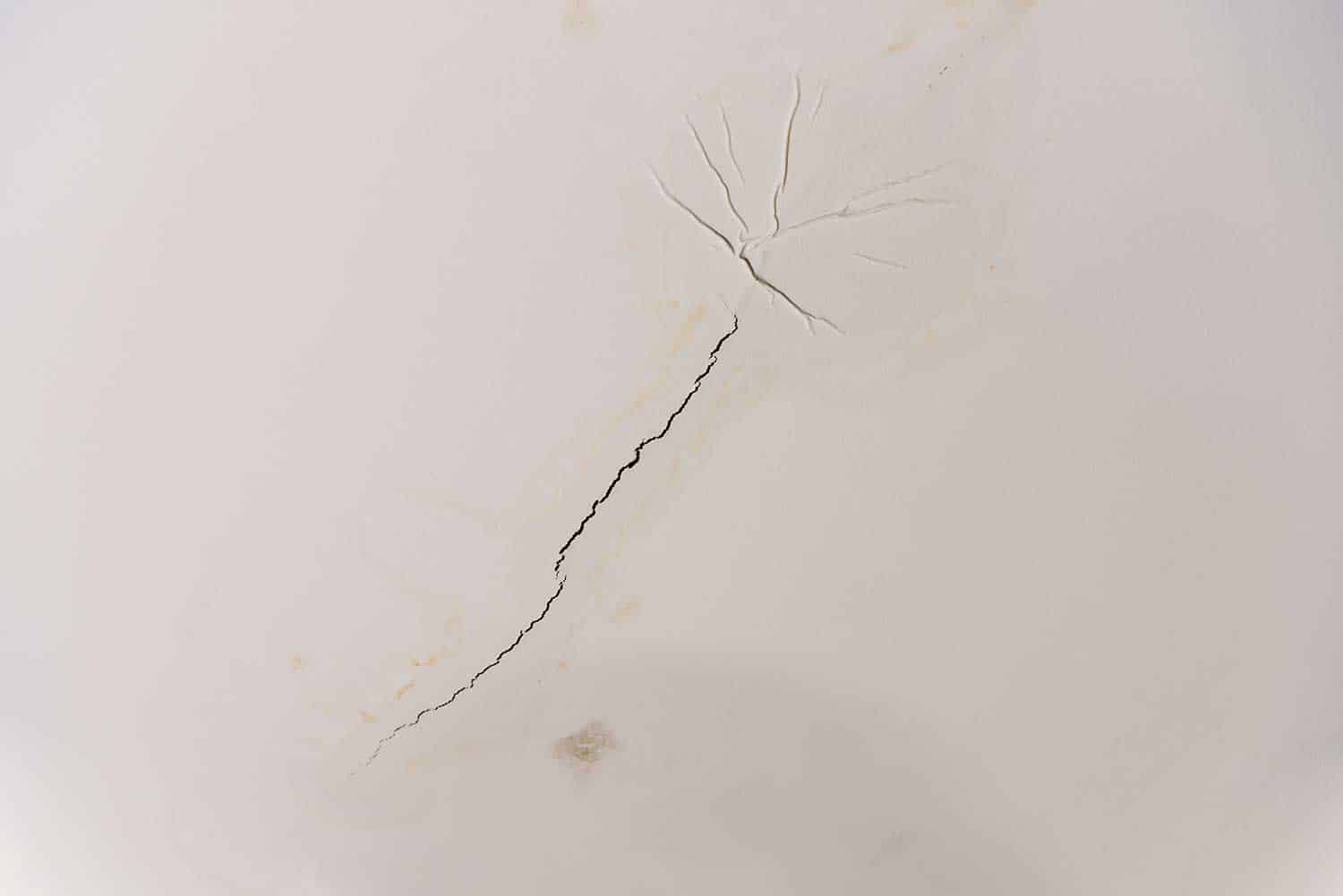how to fix hairline cracks in drywall ceiling
We may get commissions for purchases made through links in this post.
If you've noticed a crack in your ceiling, you may be wondering if it's something you should worry about or how to fix it. Ceiling cracks may seem like a daunting challenge, but we've done the research for you and can help you determine what to do with cracks and if there's cause for concern.
There are many different types of ceiling cracks, ranging from superficial cracks caused by installation errors to structural cracks caused by major issues. Some of the types of ceiling cracks are:
- Hairline cracks
- Straight cracks
- Brown or yellow cracks
- Spiderweb cracks
- Cracks between the wall and ceiling
- Large, deep cracks in a bowed ceiling
What do the different types of cracks mean? How do I know if a ceiling crack is serious? What are the best fillers for ceiling cracks? Keep reading to learn the answers to these questions and how to identify the cause of your ceiling cracks.

Hairline cracks
Cause
Hairline cracks are usually caused by an issue with the plaster over the drywall. Temperature or humidity fluctuation can cause the plaster to swell or contract, creating small cracks. These aren't serious and can be easily fixed by minor cosmetic touch-ups.
Repair
Hairline cracks are rarely a cause for concern. You can ignore them or use a paint touch up to repair.

Buy white paint touch up from Amazon here.
Straight cracks
Cause
Fine, straight cracks are usually caused by an improper taping or mudding job during installation. If there was not a sufficient amount of mud applied, the tape won't stick to the joints and pulls away, causing a crack in the plaster. Excess humidity and the settling of your house may also cause straight cracks.
Repair
Because these cracks are typically superficial, you can likely apply some drywall compound to the tape and stick it back to the joints. Sometimes, you might have to replace the tape. To do this, you'll want to use a razor knife to remove the loose tape and sand the surface underneath, so it's easy for the new tape to stick. Make sure you don't sand into the drywall paper.
Reapply a new strip of tape and use a flat putty knife to spread a thin layer of drywall compound over the area. Let it dry before you sand the surface again to ensure it's smooth.

Click here to purchase a drywall compound from Amazon.
Brown or yellow cracks
Cause
If you notice discolored cracks on your ceiling, it's likely from a water leak. It's important to take the time to find the cause and take care of the leak before you repair your drywall. It's best to call in a professional to assess the problem or risk making it worse.
Repair
After the cause of the water damage is fixed, you'll need to repair your ceiling. You'll want to dry out your ceiling before you go to work on it. If the affected area is large or if the drywall is completely soaked through, you must remove the affected sections completely.
How to remove drywall
First, remove the drywall from your ceiling, use a knife to cut away where the molding meets the drywall. Use a small mallet or sledgehammer to make holes in the center of the drywall carefully, so you don't hit the joists and cause further structural damage. Once you've made a sizeable hole, you can use a crowbar or other leveraging device to pry away the remaining drywall carefully. Make sure you're wearing gloves.
Check out HomeDepot's guide on how to remove drywall; click here.
How to put up ceiling drywall
Mark existing fixtures on your new drywall and create a pencil outline so you can cut out holes for them later. Next, sand the edges of your drywall, so they all have clean, straight edges. You'll need a special drywall adhesive to stick the drywall to the joists. Use t-braces to keep your drywall in place. These keep the drywall to the ceiling while the adhesive sets.

Click here to purchase a drywall adhesive from Amazon.
Spiderweb cracks
Cause
Cracks that look like spiderwebs are usually from foundational settling. Sometimes, it can be a sign of compromised structural integrity, but if the cracks are thinner than 1/16th of an inch, they probably aren't serious. Sometimes, drywall that's applied to thickly can also cause thin, web-like cracks as it shrinks while drying.

Repair
Most of the time, spiderweb cracks aren't a big issue, and all you have to do to fix it is sand off some of the old compound and apply a fresh coat.

For small, quick fixes, check out a drywall repair from Amazon here.
Cracks between the wall and ceiling
Cause
If you notice a crack between your wall and your ceiling, it's likely due to truss uplift. The trusses of a roof are designed to shift and move as the wood expands and contracts with constantly changing humidity and heat. The trusses could shift and lift your ceiling away from your wall. Even a heavy windstorm can shift the trusses enough to cause the ceiling to lift away and cause a gap between the wall. This especially common when drywall on a non-load-bearing wall is incorrectly attached to the ceiling.
Repair
Because these cracks do not result from compromised structural integrity, you can cover it up with a layer of paint or placing crown molding along the ceiling. If you opt for crown molding, check out our post, Should You Paint Crown Molding Before Installation. However, if you want the issue fixed, it's best to hire a professional for the job.
Large, deep cracks in a bowed ceiling
Cause
If there are large cracks in the center of your ceiling accompanied by a bow, it usually means there is serious structural damage. These can be caused by excess weight on the floor above the ceiling, heavy water damage, or even excessive settling. In older homes, it's common for cracks to form as a result of damaged foundations. Removal of a load-bearing wall without additional support replacements can also cause partial collapse of a ceiling.
Repair
You'll want to immediately remove everything on the floor above and below the crack, just in case the ceiling collapses. A professional will be needed to help determine the crack's cause and the best course of action to fix it.
Can you paint over hairline cracks?
If you notice small or hairline cracks in your ceiling, it's likely there is nothing structurally wrong. Painting over these cracks is a quick, cosmetic fix.
What are the best fillers for ceiling cracks?
Drywall Patch
Drywall patches are small sections of mesh you can place over small holes or cracks in drywall. You can spread compound over the patch with a putty knife, let it dry, and paint over the area. It will look as good as new.

Purchase drywall patches from Amazon here.
Crack Tape
If you have non-serious, thin cracks, you can purchase some special tape to lay over it. Similar to a drywall patch, the crack tape is made of mesh and rolls over the crack to provide additional support to prevent further cracking. In a convenient roll, especially good for long cracks, you can apply the tape and plaster over it to create smooth-looking drywall you can then paint over.

Purchase a roll of drywall crack tape from Amazon here.
Drywall Putty
Drywall putty is pretty simple to use, and it's easiest on small cracks or holes. To use this, you'll layer some putty on a putty knife and spread it over the crack or hole until the putty fills it. Scrape away any excess and let the putty dry. It will look almost as if the hole or crack was never there.

Purchase drywall-patching putty from Amazon here.
How do you know if a ceiling crack is serious?
Generally, smaller cracks are more superficial, while deep cracks are structural and much more serious. If you have any concerns, it's best to consult a professional and catch any problems before they grow larger.
When should you worry about cracks in the ceiling?
Ceiling cracks are always cause to worry because they mean something is wrong. Smaller cracks that are more superficial aren't causing much worry, but large cracks could mean serious issues that should be addressed immediately. For these cases, it's best to consult a professional.
In summary
Noticing a crack in your ceiling can be worrisome, but many different types are ranging in severity. Smaller cracks are usually less serious and can be repaired on your own. Larger and deeper cracks suggest structural issues and should only be handled by a professional. It's always best to call in a professional to get a second opinion, but with any luck, all you'll need is some drywall tape or putty to get your ceiling looking as good as new.
how to fix hairline cracks in drywall ceiling
Source: https://uooz.com/types-of-ceiling-cracks/
Posted by: dukesligh1984.blogspot.com

0 Response to "how to fix hairline cracks in drywall ceiling"
Post a Comment